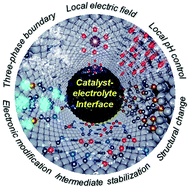Catalyst–electrolyte interface chemistry for electrochemical CO2 reduction†
Abstract
The electrochemical reduction of CO2 stores intermittent renewable energy in valuable raw materials, such as chemicals and transportation fuels, while minimizing carbon emissions and promoting carbon-neutral cycles. Recent technoeconomic reports suggested economically feasible target products of CO2 electroreduction and the relative influence of key performance parameters such as faradaic efficiency (FE), current density, and overpotential in the practical industrial-scale applications. Furthermore, fundamental factors, such as available reaction pathways, shared intermediates, competing hydrogen evolution reaction, scaling relations of the intermediate binding energies, and CO2 mass transport limitations, should be considered in relation to the electrochemical CO2 reduction performance. Intensive research efforts have been devoted to designing and developing advanced electrocatalysts and improving mechanistic understanding. More recently, the research focus was extended to the catalyst environment, because the interfacial region can delicately modulate the catalytic activity and provide effective solutions to challenges that were not fully addressed in the material development studies. Herein, we discuss the importance of catalyst–electrolyte interfaces in improving key operational parameters based on kinetic equations. Furthermore, we extensively review previous studies on controlling organic modulators, electrolyte ions, electrode structures, as well as the three-phase boundary at the catalyst–electrolyte interface. The interfacial region modulates the electrocatalytic properties via electronic modification, intermediate stabilization, proton delivery regulation, catalyst structure modification, reactant concentration control, and mass transport regulation. We discuss the current understanding of the catalyst–electrolyte interface and its effect on the CO2 electroreduction activity.

- This article is part of the themed collection: Electrochemistry in Energy Storage and Conversion


 Please wait while we load your content...
Please wait while we load your content...